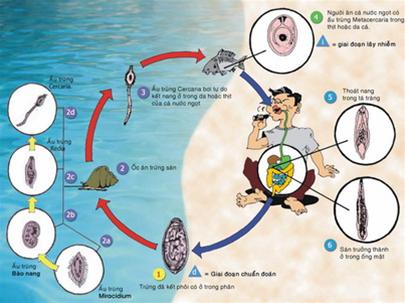Some regions in Phu Yen, Nam Dinh… are becoming “hot spots” for infections from dangerous parasites such as small liver flukes and intestinal flukes.
Meanwhile, preliminary results from the parasitic disease project originating from aquatic sources in Vietnam (FIBOZOPA), implemented in several areas, also indicate a concerning rate of fluke infections in humans. In a conversation with Tuổi Trẻ, Mr. Bui Ngoc Thanh – project manager of FIBOZOPA – shared further insights on this issue:
In Vietnam, parasitic species that cause diseases in humans originating from aquatic sources (such as the small liver fluke Clonorchis sinensis/Opisthorchis viverrini, which causes bile duct cancer and gallstones) have a relatively high infection rate. This is not only a public health issue but also a food safety concern in rural areas and regions involved in aquaculture for export.

The life cycle of the fluke (Photo: TTO)
* Sir, why do some provinces have a high rate of parasite infections in people?
– According to numerous studies, humans are primarily infected with these parasites due to the practice of eating raw freshwater fish (common in Nam Dinh, Ninh Binh), live fish dishes (eating fish that are still swimming, prominent in Phu Yen), or other fish dishes that are not fully cooked.
* Sir, what studies have been published in Vietnam regarding the risk of fish, snails… carrying parasites that can spread to humans?
– In Vietnam, as far as we know, there has not yet been a large-scale and comprehensive investigation of these parasites in freshwater fish. However, according to the World Health Organization (WHO), there are at least seven species of freshwater fish in Vietnam that may carry the larvae of small liver flukes, with high infection rates often observed in white catfish and tilapia.
Additionally, the FIBOZOPA project has conducted field investigations, and preliminary research results indicate a rate of fluke infections in humans and farmed fish in several provinces. The specifics are as follows:
+ In Nam Dinh, tests conducted on 600 male household heads in Nghia Phu and Nghia Lac communes, Nghia Hung district, showed that the rate of people infected with pathogenic parasites reached up to 65%, including two main groups of flukes: intestinal flukes and small liver flukes. In 2006, the project will carry out an in-depth study on these fluke species in freshwater fish in Nam Dinh.
+ In Nghe An, tests on more than 1,300 male household heads involved in aquaculture activities across five districts (Nam Dan, Hung Nguyen, Tan Ky, Thanh Chuong, and Yen Thanh) revealed a very low infection rate of flukes: less than 1%. However, research on freshwater fish in these districts indicated a relatively high infection rate of larvae, ranging from 30-40%.
* Sir, do the types of parasites you mentioned die in boiling water?
– These parasites found in fish will die in high-temperature environments. If fish are cooked thoroughly, the risk of parasite infection will be completely eliminated. According to some studies by scientists, the larvae of the liver fluke (Clonorchis sinensis) can survive for up to 2.5 hours at a temperature of 40°C.
However, at 65°C, these larvae will die within just 3 minutes. Nevertheless, to ensure stability and long-term safety, it is essential to implement strict solutions in aquaculture to control potential hazards affecting fish farming systems.
QUOC THANH conducted this interview



















































